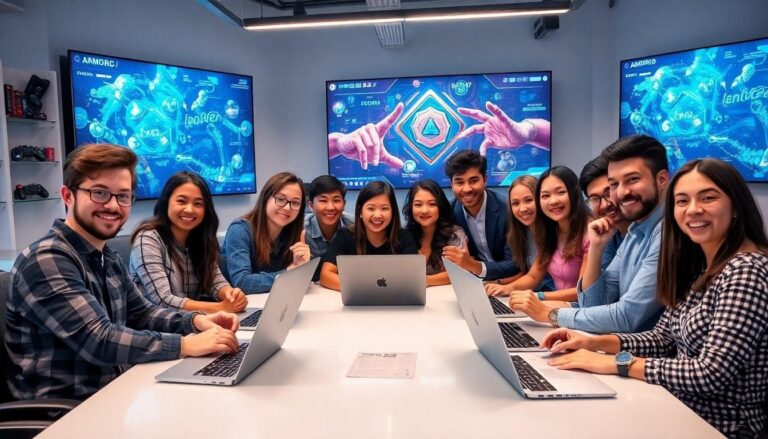Imagine stepping into a virtual world without the hassle of clunky headsets or motion sickness. Welcome to non-immersive VR, where the magic of virtual reality meets the simplicity of your everyday screen. It’s like watching a movie where you can interact, but you won’t find yourself dodging imaginary flying objects or tripping over your cat.
Overview of Non Immersive VR
Non-immersive virtual reality (VR) provides a simplified way to engage with virtual environments without the need for specialized hardware. Users interact with these environments using common devices like computers, tablets, or smartphones. This accessibility makes non-immersive VR appealing for a wider audience.
Content often resembles interactive media, allowing users to explore scenarios through a visual display. Interactivity remains a key feature, with options for choices and manipulations that enhance user experience. Examples of non-immersive VR include video games and interactive educational software.
Many businesses utilize non-immersive VR for training and simulations, showcasing its practical applications. Programs can simulate real-world situations where participants gain valuable skills without physical risks. Various industries, such as automotive and healthcare, have adopted this approach for effective learning.
Challenges exist, including limitations in user engagement compared to immersive VR. Users might experience a less impactful connection to the virtual environment due to the lack of sensory depth. However, advancements continue to improve the quality of non-immersive experiences, making them more engaging over time.
Through constant development, non-immersive VR has become a significant tool in education and marketing. Users benefit from versatile applications that cater to different interests, ensuring a broad reach. This evolution in virtual reality reflects the growing importance of digital interactions in everyday life.
Key Features of Non Immersive VR

Non-immersive VR offers unique features that enhance user engagement in various contexts.
User Interaction
User interaction defines the experience in non-immersive VR. He or she can navigate virtual spaces through simple input devices such as keyboards, mice, or touchscreen gestures. Users engage with content via clicks or taps, allowing for immediate feedback. This setup promotes an intuitive experience, making it accessible even for those with minimal technical skills. Various applications include educational software where students answer questions while exploring virtual landscapes. Businesses often leverage this interaction for training simulations. Participants practice skills and receive instant evaluations or scores, improving learning outcomes.
Visual Experience
The visual experience in non-immersive VR creates an engaging atmosphere. Graphics often resemble high-quality video game designs, delivering vivid details and smooth animations. Users view environments on standard screens, which allows them to focus more on the content than on hardware limitations. Diverse visual styles cater to different interests, from realistic simulations in healthcare to animated adventures in gaming. Developers continuously enhance visuals through advanced rendering techniques, ensuring an appealing aesthetic. Sharp graphics combined with fluid motion provide a more enjoyable experience, fostering greater participation and retention in learning or entertainment.
Applications of Non Immersive VR
Non-immersive VR finds diverse applications across various sectors, providing engaging interactions in accessible formats. The following examples illustrate its versatility.
Education and Training
Educational institutions increasingly utilize non-immersive VR for interactive lessons. Through programs, students engage with content that promotes active learning. For instance, platforms allow students to explore historical sites or biological processes visually. This method bolsters understanding, enabling students to grasp concepts more effectively. Furthermore, training simulations assist professionals in practicing skills without real-world consequences, making learning safe and efficient.
Gaming and Entertainment
The gaming sector thrives on non-immersive VR experiences, delivering interactive content on popular platforms. Players engage with rich narratives and dynamic environments, experiencing games through familiar devices. Rich graphics and thoughtful designs enhance immersion while retaining accessibility. Many titles incorporate user-friendly interfaces that encourage participation across various age groups. As a result, gaming studios consistently create engaging experiences that captivate both casual players and enthusiasts.
Marketing and Advertising
Businesses leverage non-immersive VR to create compelling marketing campaigns. Interactive advertisements draw consumers in by enabling them to explore products or services virtually. For example, potential buyers can visualize furniture in their own homes using augmented reality features. Engagement levels increase when brands incorporate storytelling and immersive content into their strategies. Marketers recognize the value of these experiences, transforming how consumers connect with brands and make purchasing decisions.
Advantages and Disadvantages of Non Immersive VR
Non-immersive VR offers several advantages, making it an attractive option for many users.
Pros of Non Immersive VR
Accessibility characterizes non-immersive VR since it doesn’t require specialized hardware. Users easily engage with virtual environments through devices like computers or tablets. Increased convenience promotes a wider audience base, allowing more people to enjoy interactive experiences. Educational applications benefit immensely, as students experience active learning through visually rich content. Businesses also leverage non-immersive VR for effective training simulations and marketing strategies, fostering innovative engagement with consumers. Interactivity enhances user experiences as individuals navigate environments intuitively, allowing for immediate feedback that improves knowledge retention. Overall, non-immersive VR caters to diverse needs across sectors, delivering effective solutions with ease.
Cons of Non Immersive VR
Limited sensory engagement presents a challenge for non-immersive VR. Users experience a disconnect from the virtual environment, reducing emotional involvement. Depth perception remains less effective compared to immersive experiences, leading to decreased impact. Frustration may arise for some users due to the absence of realistic interactions, causing dissatisfaction with the overall experience. Furthermore, advancements in immersive technologies create a competitive landscape that can overshadow non-immersive VR options. Budget constraints also hinder development of high-quality visuals, which affects overall satisfaction. Although limitations exist, continued innovation may address these issues over time.
Future Trends in Non Immersive VR
Technological advancements are driving the evolution of non-immersive VR. Innovations increase accessibility and engagement for users across various platforms. Improved graphics engines and user interface designs create more visually appealing experiences, thus enhancing participation.
Gamification strategies are being applied to non-immersive VR applications. These strategies incorporate game-like elements into educational content, motivating users to interact more frequently through rewards and challenges. Adoption of gamification in training programs promotes a fun approach to skill development.
Artificial intelligence (AI) is integrating into non-immersive VR experiences. AI facilitates personalized interactions by adapting content to user preferences and behaviors, resulting in tailored educational lessons or training simulations. Continuous data collection allows for real-time adjustments to enhance user engagement.
Social interaction features are becoming more prevalent in non-immersive VR. Platforms now allow users to connect and collaborate within virtual environments, making shared experiences possible. This trend serves to create a community feeling, even while participating remotely.
Cloud computing also plays a significant role in the future of non-immersive VR. Cloud-based platforms enable users to access rich content without needing powerful hardware, ensuring a broader audience can engage with high-quality experiences. Resources stored online streamline delivery and updating processes, enhancing the user experience.
Lastly, analytics are becoming increasingly essential for businesses utilizing non-immersive VR. Detailed insights into user behavior help industries refine their approaches, ensuring more effective training and marketing strategies. Data-driven decisions facilitate continuous improvement, promoting long-term user satisfaction.
Conclusion
Non-immersive VR stands out as a practical and accessible option for users seeking virtual experiences without the complexities of immersive technology. Its ability to engage a wider audience through familiar devices makes it a valuable tool across various sectors.
As advancements in graphics and interactivity continue to evolve, non-immersive VR is poised to enhance educational and marketing initiatives significantly. Despite its limitations in sensory engagement, ongoing innovations promise to bridge these gaps, making non-immersive VR an increasingly influential player in the digital landscape.
The future looks bright for this technology as it adapts to meet user needs and preferences, ensuring its relevance in an ever-changing digital world.




